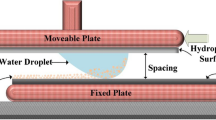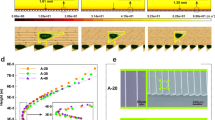Abstract
Recently, drone has been used in various fields other than the military (defense) industry, including agriculture, leisure, and transportation. Most drones with high-velocity abilities are significantly affected by rain droplets when flying at this high velocity in rainy weather. As a result, the flying of almost all drones in rainy weather has been prohibited. We propose micro-pattern structures that can maintain hydrophobicity under static conditions and reduce the impact force during dynamic raindrop impingement. The case of a single droplet was analyzed, and the ability to control the collision force based on whether or not a structure exists was demonstrated. Further, the influence of the rebound time on the collision velocity, parameter ratio, and collision angle was analyzed. The analysis was then performed while considering the interaction of multiple droplets (two droplets). The influence of the rebound time, determined by the difference in the velocity at which the two droplets overlap; collision time; and incident angle was analyzed. It was proved that by controlling the dynamic flow characteristics through and rebound time of water droplets through surface shape deformation, the impact force can be minimized.
Access this article
We’re sorry, something doesn't seem to be working properly.
Please try refreshing the page. If that doesn't work, please contact support so we can address the problem.















Similar content being viewed by others
References
Abdel-Rahman AA, Chakroun WM (1997) Surface roughness effects on flow over aerofoils. Wind Eng 125–137
Asaro PM (2013) The labor of surveillance and bureaucratized killing: new subjectivities of military drone operators. Soc Semiot 23(2):196–224
Backholm M, Molpeceres D, Vuckovac M, Nurmi H, Hokkanen MJ, Jokinen V, Ras RH (2020) Water droplet friction and rolling dynamics on superhydrophobic surfaces. Commun Mater 1(1):1–8
Bhushan B, Jung YC (2008) Wetting, adhesion and friction of superhydrophobic and hydrophilic leaves and fabricated micro/nanopatterned surfaces. J Phys Condens Matter 20(22):225010
Brasseur JG, Wei T (2010) Designing large-eddy simulation of the turbulent boundary layer to capture law-of-the-wall scaling. Phys Fluids 22(2):021303
Chamakos NT, Kavousanakis ME, Boudouvis AG, Papathanasiou AG (2016) Droplet spreading on rough surfaces: Tackling the contact line boundary condition. Phys Fluids 28(2):022105
Custers B (2016) Future of drone use. TMC Asser Press, The Hague, pp 3–20
De Ruijter MJ, De Coninck J, Oshanin G (1999a) Droplet spreading: partial wetting regime revisited. Langmuir 15(6):2209–2216
De Ruijter MJ, Blake TD, De Coninck J (1999b) Dynamic wetting studied by molecular modeling simulations of droplet spreading. Langmuir 15(22):7836–7847
Ding H, Spelt PD (2007) Inertial effects in droplet spreading: a comparison between diffuse-interface and level-set simulations. J Fluid Mech 576:287–296
Dou HS, Xu W, Khoo BC (2018) Stability of boundary layer flow based on energy gradient theory. Mod Phys Lett B 32(12n13):1840003
Fukagata K, Kasagi N, Koumoutsakos P (2006) A theoretical prediction of friction drag reduction in turbulent flow by superhydrophobic surfaces. Phys Fluids 18(5):051703
Gaver DP, Grotberg JB (1992) Droplet spreading on a thin viscous film. J Fluid Mech 235:399–414
Gupta A, Kumar R (2010) Droplet impingement and breakup on a dry surface. Comput Fluids 39(9):1696–1703
Haley PJ, Miksis MJ (1991) The effect of the contact line on droplet spreading. J Fluid Mech 223:57–81
Kaminski ME (2013) Drone federalism: civilian drones and the things they carry. Calif l Rev Circuit 4:57
Kreps SE, Wallace GP (2016) International law, military effectiveness, and public support for drone strikes. J Peace Res 53(6):830–844
Marzbali M, Dolatabadi A (2020) High-speed droplet impingement on dry and wetted substrates. Phys Fluids 32(11):112101
Moqaddam AM, Chikatamarla SS, Karlin IV (2017) Drops bouncing off macro-textured superhydrophobic surfaces. J Fluid Mech 824:866–885
Olin P, Lindström SB, Pettersson T, Wågberg L (2013) Water drop friction on superhydrophobic surfaces. Langmuir 29(29):9079–9089
Patil ND, Bhardwaj R, Sharma A (2016) Droplet impact dynamics on micropillared hydrophobic surfaces. Exp Therm Fluid Sci 74:195–206
Qu J, Yang Y, Yang S, Hu D, Qiu H (2019) Droplet impingement on nano-textured superhydrophobic surface: experimental and numerical study. Appl Surf Sci 491:160–170
Savva N, Kalliadasis S, Pavliotis GA (2010) Two-dimensional droplet spreading over random topographical substrates. Phys Rev Lett 104(8):084501
Ulbrich CW (1983) Natural variations in the analytical form of the raindrop size distribution. J Clim Appl Meteorol 22(10):1764–1775
Winkler S, Zeadally S, Evans K (2018) Privacy and civilian drone use: the need for further regulation. IEEE Secur Priv 16(5):72–80
Ybert C, Barentin C, Cottin-Bizonne C, Joseph P, Bocquet L (2007) Achieving large slip with superhydrophobic surfaces: Scaling laws for generic geometries. Phys Fluids 19(12):123601
Yonemoto Y, Kunugi T (2017) Analytical consideration of liquid droplet impingement on solid surfaces. Sci Rep 7(1):1–11
Yuan Z, Matsumoto M, Kurose R (2021) Directional rebounding of a droplet impinging hydrophobic surfaces with roughness gradients. Int J Multiphase Flow 138:103611
Zhang G, Quetzeri-Santiago MA, Stone CA, Botto L, Castrejón-Pita JR (2018) Droplet impact dynamics on textiles. Soft Matter 14(40):8182–8190
Acknowledgements
This work was supported by the National Research Foundation of Korea (NRF) grant funded by the Korea government (MSIT) (2021R1A2C2013053).
Author information
Authors and Affiliations
Corresponding author
Additional information
Publisher's Note
Springer Nature remains neutral with regard to jurisdictional claims in published maps and institutional affiliations.
Rights and permissions
About this article
Cite this article
Park, DS., Park, KS. Mitigation of raindrop impact using the multi-functional surface micro-patterns. Microsyst Technol 28, 2203–2214 (2022). https://doi.org/10.1007/s00542-022-05255-2
Received:
Accepted:
Published:
Issue Date:
DOI: https://doi.org/10.1007/s00542-022-05255-2




